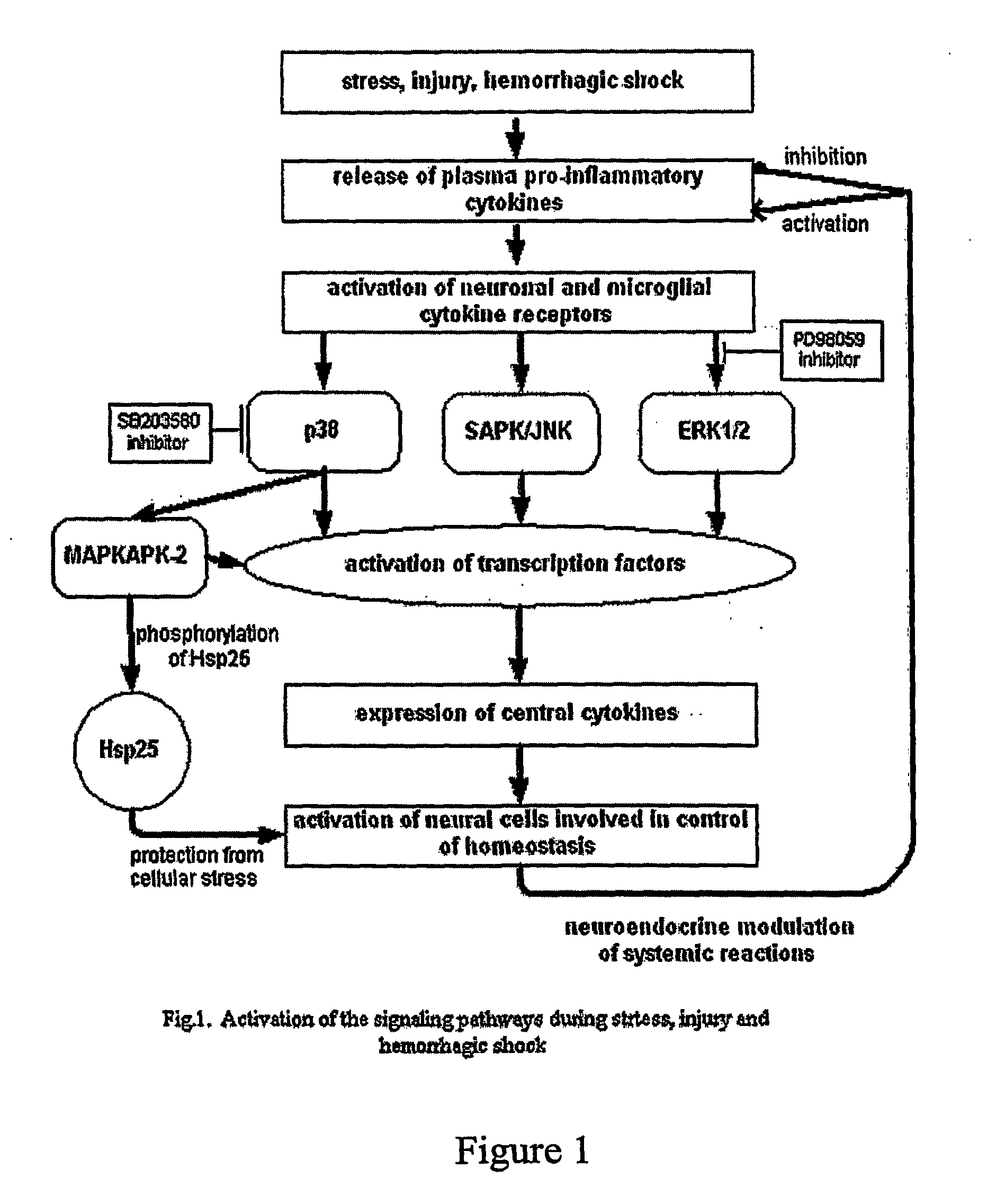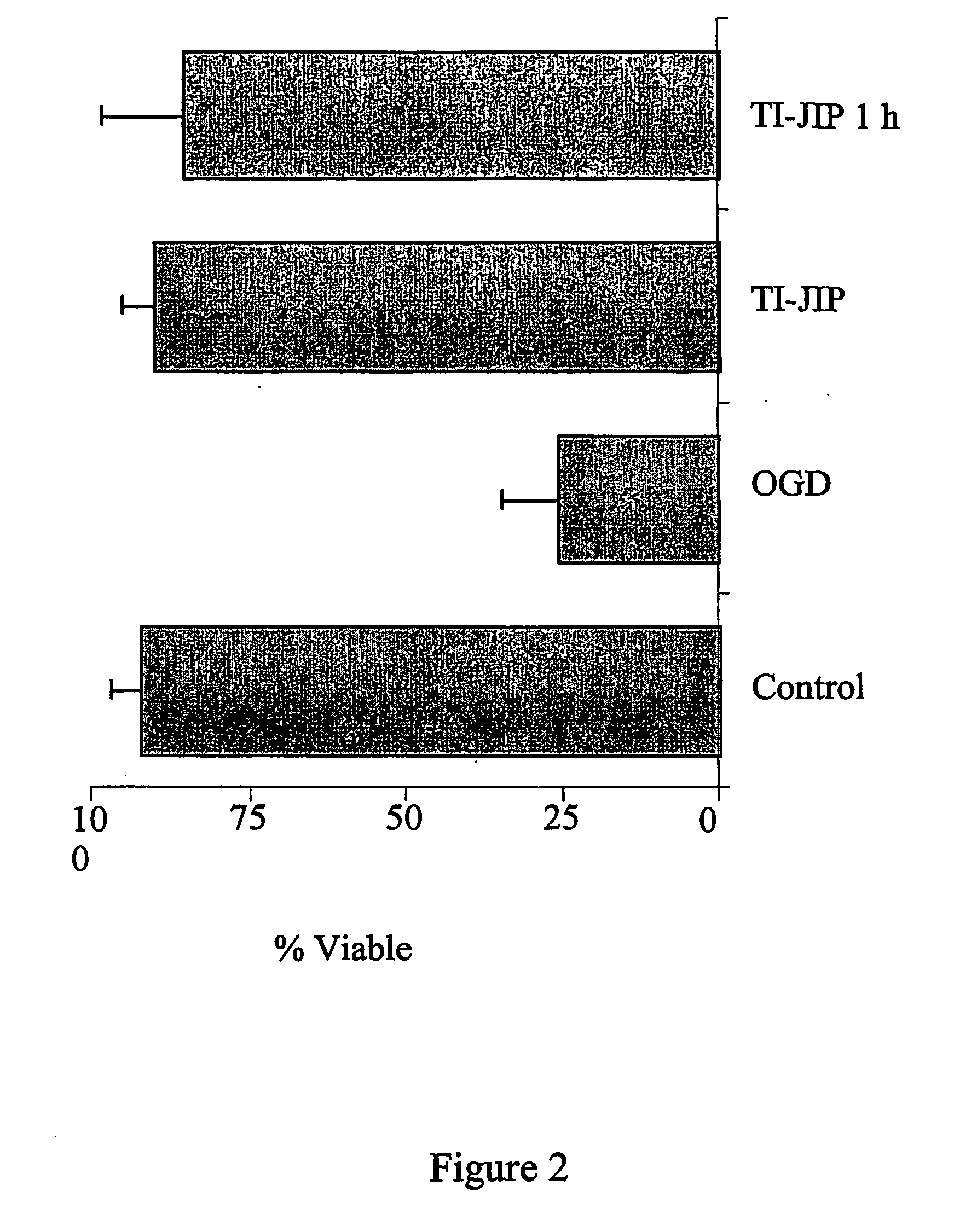Genetic Screen for Interaction Interface Mapping
a technology of interaction interface and gene screen, which is applied in the field of gene screen for interaction interface mapping, can solve the problems of steric hindrance, inability to achieve specificity of specific protein or signalling pathway modulation, and necessarily permit fine structure mapping, so as to achieve rapid identification of site of interaction, the number of false positives identified using reverse hybrid screening approaches can be minimized or significantly reduced
- Summary
- Abstract
- Description
- Claims
- Application Information
AI Technical Summary
Benefits of technology
Problems solved by technology
Method used
Image
Examples
example 1
Developing Novel Therapeutic Leads Based Upon JNK MAPK Inhibitory Peptides
[0317]Introduction
[0318]This example describes new approaches to improve our understanding of specific inhibitors of the JNK MAPKs. These protein kinases, first described following their activation in response to stress, have been implicated in the intracellular events culminating in cell death. Because cell death underlies the pathologies of stroke and heart attack that are associated with the ischemia / reperfusion damage, the targeted inhibition of JNK promises an important therapeutic strategy.
[0319]Recently, an inventor described a small peptide inhibitor of JNK (MAB3), derived from an organiser / scaffold of the JNK pathway, designated “TI-JIP” (Truncated Inhibitor of JNK based on I). The inventors now have data supporting the efficacy of this inhibitor in protecting neuronal cells following ischemia / reperfusion. Data presented in FIG. 1 demonstrate that the cell-permeable TI-JIP maintains neuronal cell viab...
example 2
Validation of Inhibitors of the JNK1 / TI-JIP Interaction Using a Reverse Three Hybrid Assay With Dual Baits
[0384]Chang et al., J. Biol. Chem 278, 9195-9202, 2003 showed that murine WOX1 and human WOX3 interact with human JNK1 via the WW domain in the N-terminus of the WOX protein, however human WOX3 protein appears to promote higher endogenous activation of gene expression than murine WOX1. This is presumably due to the presence of an activation domain in WOX3 that is produced as consequence of the deletion in WOX3 that truncates and modifies the C-terminus of the protein relative to WOX1.
[0385]The interaction interface between TI-JIP and JNK1 (Example 1) is confirmed using a reverse three hybrid assay PCT / US01 / 07669). The binding partners assayed are JNK (SEQ ID NO: 1) and TI-JIP (SEQ ID NO: 4) as described in the preceding example, and a WOX protein selected from the group consisting of human WOX3 (SEQ ID NO: 17), human WOX1 (SEQ ID NO: 18) and murine WOX3 (SEQ ID NO:. 19). Alterna...
example 3
Identification of TI-JIP Mimetic Compounds
[0387]This example describes the identification of mimetic compounds of TI-JIP that are identified in a screen of a BGF library derived from biodiverse microbial genomes created and validated as described in U.S. Ser. No. 10 / 372,003. With this BGF library, the inventors will identify new peptides utilizing the JNK-TI-JIP interface. Data already obtained with this library suggests that the encoded peptides yield 10 to 1000-fold better hit rates than the best rates reported from comparable screens of random peptides in aptamer libraries. Using in vitro assays, the inventors will confirm the ability of peptide mimotopes to inhibit JNK and prevent neuronal apoptosis. Non-peptide small inhibitor molecules of JNK are also identified. The technologies used are broadly applicable to emerging approaches to target protein-protein interaction interfaces in general. Novel peptides that also the TI-JIP / JNK interface are identified using the screening app...
PUM
| Property | Measurement | Unit |
|---|---|---|
| Concentration | aaaaa | aaaaa |
| Structure | aaaaa | aaaaa |
| Length | aaaaa | aaaaa |
Abstract
Description
Claims
Application Information
 Login to View More
Login to View More - R&D
- Intellectual Property
- Life Sciences
- Materials
- Tech Scout
- Unparalleled Data Quality
- Higher Quality Content
- 60% Fewer Hallucinations
Browse by: Latest US Patents, China's latest patents, Technical Efficacy Thesaurus, Application Domain, Technology Topic, Popular Technical Reports.
© 2025 PatSnap. All rights reserved.Legal|Privacy policy|Modern Slavery Act Transparency Statement|Sitemap|About US| Contact US: help@patsnap.com



